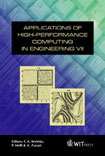High Performance Computing For Analysis And Postprocessing Of Earthing Systems In Layered Soils
Price
Free (open access)
Volume
27
Pages
Published
2002
Size
631 kb
Paper DOI
10.2495/HPC020101
Copyright
WIT Press
Author(s)
I. Colominas, J. Gómez-Calviño, F. Navarrina & M. Casteleiro
Abstract
High performance computing for analysis and postprocessing of earthing systems in layered soils I. Colominas, J. Gomez-Calvino, F. Navarrina, M. Casteleiro Group of Numerical Methods in Engineering (http://caminos.udc. Es/gmni) Civil Engineering School, University of La Coruna, SPAIN Abstract In this paper, we present a BEM formulation for the analysis and postprocessing of grounding systems embedded in layered soils, and we discuss the highligths of its implementation in a High-Performance Parallel Computer. The feasibility of this approach is demonstrated by its application to the analysis of a real grounding system with a two-layered soil model. 1 Introduction From the early beginnings of the industrial use of electricity, obtaining the potential distribution when an electrical current is derived into the soil through a \“grounded electrode” has been one of the challenging problems in the electrical engineering field. In most large electrical installations, the \“grounding grid” consists of a mesh of interconnected cylindrical conductors, horizontally buried and supplemented by ground rods vertically thrusted in certain places of the substation site. Its main objective is the transport and dissipation of electrical currents produced during fault conditions into the ground, ensuring that a person in the vicinity of the grounded installation is not exposed to a critical electrical shock, and preserving the continuity of the power supply and the integrity of the equipment. To attain these goals, the apparent electrical resistance of the grounding system must be low enough to guarantee that fault currents dissipate mainly through the grounding electrode into the soil. Moreover, the electrical potential differences between close points on the earth surface that can be connected by a person must be kept under certain maximum safe limits (step, touch and mesh voltages) [l].
Keywords




